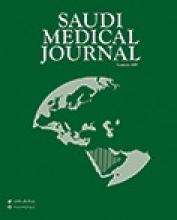Abstract
OBJECTIVE: To assess the efficiency and safety of hydroxyurea in patients with sickle cell disease from the Eastern Province, Kingdom of Saudi Arabia.
METHODS: The study was an open-label and uncontrolled trial. Patients older than 10 years of age with sickle cell disease who suffered 4 or more episodes of painful vaso-occlusive crises requiring admissions per year were included, 36 patients (23 males and 13 females) were included between June 1994 and June 1998. Patients were started on hydroxyurea at a dose of 8-10mg/kg per day and the dose was escalated to a maximum tolerated dose or a dose of 35 mg/kg per day. Blood count, renal and liver functions, and hemoglobin F levels were monitored regulary. Clinical response was assessed by record of number of vaso-occlusive crises, requirement for hospital admission and self scoring at the end of each year of treatment.
RESULTS: Thirty-six patients were enrolled in the study until the time of analysis of the data. The data of the first 27 patients (18 males and 9 females) who completed 12 months of therapy were analyzed and presented. There was significant reduction in leukocyte, platelet counts and rise in total hemoglobin and hemoglobin F. Hemoglobin F rose by 1.2-13 folds, from the baseline. Seventy-four percent of patients had at least 2 fold rise of maximum hemoglobin F. The mean maximum tolerated dose of hydroxyurea was 16.4 mg/kg. There was significant reduction in hospital admissions and hospital stay. No major side effects had occured.
CONCLUSION: Hydroxyurea seems to be effective in decreasing the frequency of vasooclusive crises in patient with sickle cell disease from Eastern Saudi Arabia. In this preliminary analysis no major side effects were observed. Long term side effects need to be monitored.
- Copyright: © Saudi Medical Journal
This is an open-access article distributed under the terms of the Creative Commons Attribution-Noncommercial-Share Alike 3.0 Unported, which permits unrestricted use, distribution, and reproduction in any medium, provided the original work is properly cited.






